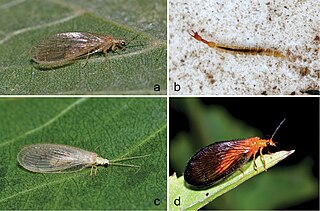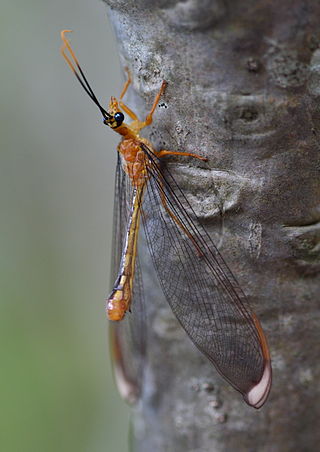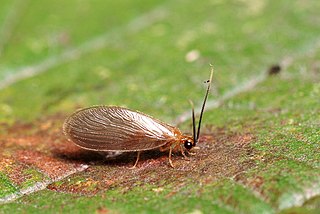
The insect order Neuroptera, or net-winged insects, includes the lacewings, mantidflies, antlions, and their relatives. The order consists of some 6,000 species. Neuroptera is grouped together with the Megaloptera and Raphidioptera (snakeflies) in the unranked taxon Neuropterida.

Snakeflies are a group of predatory insects comprising the order Raphidioptera with two extant families: Raphidiidae and Inocelliidae, consisting of roughly 260 species. In the past, the group had a much wider distribution than it does now; snakeflies are found in temperate regions worldwide but are absent from the tropics and the Southern Hemisphere. Recognisable representatives of the group first appeared during the Early Jurassic. They are a relict group, having reached their apex of diversity during the Cretaceous before undergoing substantial decline.

Psychodidae, also called drain flies, sink flies, filter flies, sewer flies, or sewer gnats, is a family of true flies. Some genera have short, hairy bodies and wings, giving them a "furry" moth-like appearance, hence one of their common names, moth flies. Members of the sub-family Phlebotominae, which are hematophagous, may be called sand flies in some countries, although this term is also used for other unrelated flies.

Mantispidae, known commonly as mantidflies, mantispids, mantid lacewings, mantisflies or mantis-flies, is a family of small to moderate-sized insects in the order Neuroptera. There are many genera with around 400 species worldwide, especially in the tropics and subtropics. Only five species of Mantispa occur in Europe. As their names suggest, members of the group possess raptorial forelimbs similar to those of the praying mantis, a case of convergent evolution.

Osmylidae are a small family of winged insects of the net-winged insect order Neuroptera. The osmylids, also called lance lacewings, stream lacewings or giant lacewings, are found all over the world except North and Central America. There are around 225 extant species.

Pelecinidae is a family of parasitic wasps in the superfamily Proctotrupoidea. It contains only one living genus, Pelecinus, with three species known from the Americas. The earliest fossil species are known from the Jurassic, and the group was highly diverse during the Cretaceous. Members of Pelecinus are parasitic on larval beetles, flies, green lacewings, and sawflies.

The Stephanidae, sometimes called crown wasps, are a family of parasitoid wasps. They are the only living members of the superfamily Stephanoidea. Stephanidae has at least 345 living species in 11 genera. The family is considered cosmopolitan in distribution, with the highest species concentrations in subtropical and moderate climate zones. Stephanidae also contain four extinct genera described from both compression fossils and inclusions in amber.

Evaniidae is a family of parasitoid wasps also known as ensign wasps, nightshade wasps, hatchet wasps, or cockroach egg parasitoid wasps. They number around 20 extant genera containing over 400 described species, and are found all over the world except in the polar regions. The larvae of these solitary wasps are parasitoids that feed on cockroaches and develop inside the egg-cases, or oothecae, of their hosts.

Hemerobiidae is a family of Neuropteran insects commonly known as brown lacewings, comprising about 500 species in 28 genera. Most are yellow to dark brown, but some species are green. They are small; most have forewings 4–10 mm long. These insects differ from the somewhat similar Chrysopidae not only by the usual coloring but also by the wing venation: hemerobiids differ from chrysopids in having numerous long veins and forked costal cross veins. Some genera are widespread, but most are restricted to a single biogeographical realm. Some species have reduced wings to the degree that they are flightless. Imagines (adults) of subfamily Drepanepteryginae mimic dead leaves. Hemerobiid larvae are usually less hairy than chrysopid larvae.

The Berothidae are a family of winged insects of the order Neuroptera. They are known commonly as the beaded lacewings. The family was first named by Anton Handlirsch in 1906. The family consists of 24 genera and 110 living species distributed discontinuously worldwide, mostly in tropical and subtropical regions. Numerous extinct species have also been described. Their ecology is poorly known, but in the species where larval stages have been documented, the larvae are predators of termites.

The Nevrorthidae are a small family of winged insects of the order Neuroptera. Extant species may be described as living fossils. There are 19 extant species in four genera, with a geographically disjunct distribution: Nevrorthus, comprising 5 species with scattered distributions around the Mediterranean; Austroneurorthus, with two species known from southeastern Australia; Nipponeurorthus, comprising 11 species known from China and Japan; and Sinoneurorthus, known from a single species described from Yunnan Province, China. They are traditionally placed in the Osmyloidea, alongside Osmylidae and the spongillaflies (Sisyridae), but some research has considered them to be the sister group to the rest of Neuroptera. The larvae have unique straight jaws that are curved at the tips, and live as unspecialised predators in the sandy bottom sediments of clear, fast flowing mountain rivers and streams. They pupate underwater on the underside of stones. The adults are likely predators or feed on honeydew and other sugar-rich fluids.

Nymphidae, sometimes called split-footed lacewings, are a family of winged insects of the order Neuroptera. There are 35 extant species native to Australia and New Guinea.

Psychopsidae is a family of winged insects of the order Neuroptera. They are commonly called silky lacewings.

Rhachiberothidae, sometimes called thorny lacewings, are a family of winged insects in the order Neuroptera. The family has only 14 extant species in 4 genera found in Sub-Saharan Africa, but has a diverse fossil record extending back to the Early Cretaceous in Lebanon, Eurasia and North America. Like the closely related Mantispidae members of the group possess raptorial forelegs, which probably only evolved once in the common ancestor of the groups.

Sisyridae, commonly known as spongeflies or spongillaflies, are a family of winged insects in the order Neuroptera. There are approximately 60 living species described, and several extinct species identified from the fossil record.
Spiloconis is a genus of lacewing.
Neoconis is a genus of lacewing.
Serphitidae is a family of microscopic parasitic wasps known from the Cretaceous period.
Umenocoleidae is an extinct family of dictyopteran insects known from the Cretaceous. They are considered to be closely related to the Alienopteridae. They were originally considered to be beetles due to their beetle-like morphology, with sclerotised elytra-like forewings. This was probably an adaptation for living under bark and in other tight spaces.

Dipteromantispidae is an extinct family of neuropterans known from the Cretaceous period. Unlike other neuropterans, the family possesses only a single set of fully developed forewings, with the hindwings reduced to haltere-like structures. They are generally small in size and possess raptorial forelegs. They are considered to belong to Mantispoidea, with an uncertain position within the clade. Some authors have suggested that they represent a subgroup of Mantispidae, and should instead be referred to as the subfamily Dipteromantispinae within that family.
















